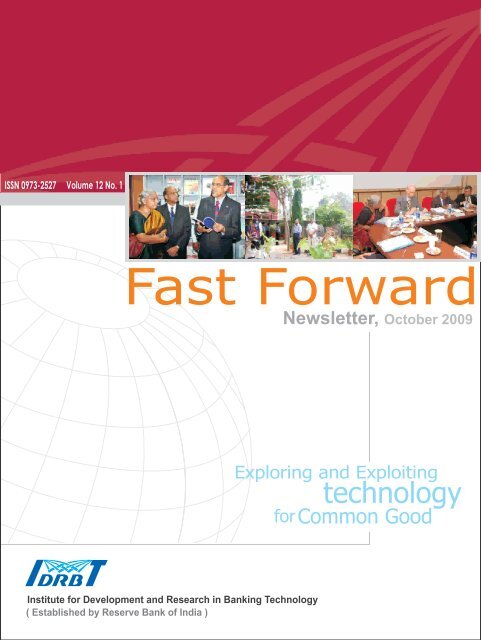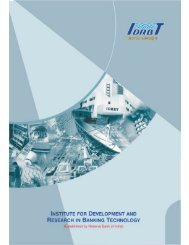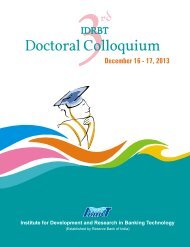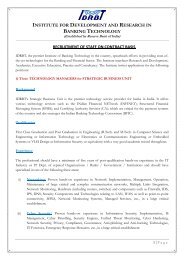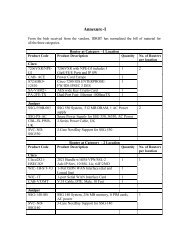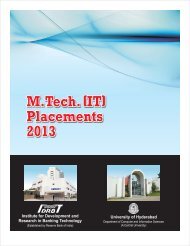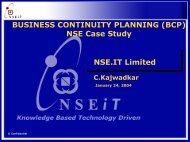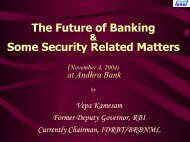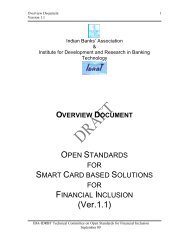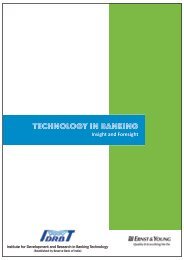Newsletter, October 2009 - IDRBT
Newsletter, October 2009 - IDRBT
Newsletter, October 2009 - IDRBT
Create successful ePaper yourself
Turn your PDF publications into a flip-book with our unique Google optimized e-Paper software.
ISSN 0973-2527 Volume 12 No. 1<br />
Fast Forward<br />
<strong>Newsletter</strong>, <strong>October</strong> <strong>2009</strong><br />
Exploring and Exploiting<br />
technology<br />
for Common Good<br />
Institute for Development and Research in Banking Technology<br />
( Established by Reserve Bank of India )
GREEN IDEAS : Dr. D. Subbarao, Governor,<br />
Reserve Bank of India, and Visitor, <strong>IDRBT</strong>,<br />
planting a sapling at the Institute on May 18, <strong>2009</strong><br />
INTELLECTUAL CAPITAL : Dr. D. Subbarao<br />
with members of the Institute's Governing Council and Staff
Fast Forward<br />
<strong>October</strong> <strong>2009</strong><br />
A CASE FOR IT GOVERNANCE IN BANKS<br />
ANKING Technology in India is now<br />
two decades old, counting from the<br />
BR a n g a r a j a n C o m m i t t e e o n<br />
Computerisation in Banks, 1989, which gave it a<br />
push. By now, most of the Banks have attained<br />
sufficient maturity in technology adoption,<br />
upgradation and even absorption. A few banks<br />
have even moved on to achieve some technology<br />
innovation capabilities. There have also been huge<br />
productivity gains.<br />
The time is ripe for the banks to concentrate more<br />
on making their IT implementation and usage<br />
more efficient and effective. They need to explore<br />
the ways and means of unlocking value from the<br />
way IT is deployed, used, controlled and<br />
integrated into the business of the bank. In short,<br />
they have to get a firm grip over IT Governance -<br />
concept, awareness and the extent and depth of<br />
implementation.<br />
What is IT Governance?<br />
IT Governance, spearheaded by the IT<br />
Governance Institute ( www.itgi.org), broadly<br />
covers the following:<br />
Alignment of IT Strategy with Business<br />
Strategy<br />
Making IT deliver Value to Banks<br />
IT Risk Management<br />
IT Resource Management and<br />
IT Performance Measurement<br />
Strategy Alignment<br />
Strategy alignment is to ensure that IT is deployed<br />
to help, maintain or improve business activity or<br />
processes. For example, a one-year-old ATM<br />
Network of a bank with only a daily average of 30<br />
transactions per ATM (TPA) when compared<br />
with its peer having over 300 TPA is a clear case of<br />
the IT telling the Business to rise and meet the IT<br />
vision and implementation.<br />
The problem here may be that the bank in<br />
question either installed more ATMs than its<br />
customers needed or the ATMs were not installed<br />
in convenient locations for their customers to fully<br />
exploit or its customer profile is such that they are<br />
not in favour of using ATMs or it may even be a<br />
case of a sheer game of numbers wherein this<br />
Bank wanted to score over its benchmark rival or<br />
competitor by installing so many ATMs.<br />
An indicator of better alignment would be<br />
enrichment of the number and nature of delivery<br />
channels with a higher proportion of products and<br />
services moved to electronic, self-service and 24/7<br />
platforms.<br />
Value Delivery from IT<br />
In simple terms Value Delivery means getting a<br />
better Return on Technology Investment (ROTI).<br />
This can be done through so many ways: reducing<br />
the cost of operations, improving revenues,<br />
launching new products and services that are IT<br />
enabled, clearly specifying and monitoring the<br />
deliverables from IT and so on.<br />
For example in transactions done through ATMs<br />
and Internet Banking, the bank is making the<br />
customer do the complete transaction himself,<br />
without any manual intervention from the bank.<br />
To that extent, the transaction load on the<br />
branches comes down. And this is a measurable<br />
savings in costs of operation, that too with<br />
improved customer satisfaction and complete<br />
accountability and responsibility laid at the<br />
customer’s door. Value Delivery from IT, as a<br />
concept, is yet to take-off in India and hence the<br />
level of awareness and commitment to this is very<br />
low in most of the banks.<br />
1
Fast Forward<br />
<strong>October</strong> <strong>2009</strong><br />
IT Risk Management<br />
Having logged into Basel II already, banks are only too aware that pervasive IT constitutes 70% of their<br />
Operational Risk. In other words, 7% of the additional capital they have to provide (with an alpha of 10%)<br />
for operational risk will be to cover their IT risks. These IT risks can be more effectively managed with an<br />
organizational mechanism, with board level commitment, which makes use of sound policies, for each and<br />
every aspect of IT deployment, usage and control, backed up by international standards and best practices.<br />
These policies get translated into procedures at the top management level and these procedures get split<br />
into detailed practices (and guidelines) for the grass root functionaries to religiously follow.<br />
A functional, supportive organisational structure is a sine qua non for the successful implementation of the<br />
policies and satisfactory achievement of the objectives. Banks need to have an effective IT Risk<br />
Management in place. In fact, it is time for the banks to take stock of the policies in place, the level of<br />
commitment, understanding and implementation, and put in place the required organisational structures<br />
to support and achieve the desired results.<br />
IT Resource Management<br />
IT Resources can be broadly classified into five major categories: Data, Applications, Technology,<br />
Facilities and People. Acquiring, maintaining, using, leveraging, protecting and ultimately ensuring that all<br />
these resources are put to effective and proper use to achieve the corporate business objectives will demand<br />
enormous clarity, time, attention and commitment from bank managements and the involvement of the<br />
rank and file.<br />
Each of these resources should have clearly defined owners, mandated access and usage control matrices,<br />
backup and recovery norms and accepted/acceptable standards of performance and reliability to make<br />
them serve the purpose for which they exist. Banks have to gear themselves up in this regard for getting the<br />
best out of their IT.<br />
NEW DIRECTIONS : A High-powered committee under the Chairmanship of<br />
Dr. C. Rangarajan reviews the Institute's activities to redefine the role of <strong>IDRBT</strong><br />
2
Fast Forward<br />
<strong>October</strong> <strong>2009</strong><br />
IT Performance Measurement<br />
This is one of the most difficult nuts to crack. This<br />
becomes all the more difficult if there is no clarity<br />
on what the IT Infrastructure is expected to deliver.<br />
Ideally we should have two inputs – what the IT<br />
Resource is expected to deliver and how it is<br />
supposed to impact the business process or<br />
objective. To start with, banks can look at the first<br />
part which may be a little easier than the second.<br />
The first part, for example, will be to measure and<br />
monitor the cost per page for using a specific<br />
printer with the help of specific warranties,<br />
guarantees and service level agreements for<br />
maintenance. What the bank does with all those<br />
print-outs or whether there are controls on what is<br />
allowed to be printed is another difficult part to be<br />
considered to arrive at the business impact of this<br />
printer (irrespective of whether it is an impact<br />
printer or not!).<br />
In short, IT Performance Measurement is all about<br />
setting or arriving at Key Goal Indicators (KGIs)<br />
and Key Performance Indicators (KPIs), prior to<br />
performance and not after. KGIs refer to progress<br />
in terms of what exactly is to be done and KPIs talk<br />
about how well the task is to be done. For example<br />
KGIs talk about milestones like number of<br />
branches or regions covered, KPIs talk about<br />
accuracy levels, satisfaction levels, organizational<br />
learning that happens in the process of<br />
implementation etc. While KGIs look at outputs,<br />
KPIs look at outcomes.<br />
The monitoring mechanism relies as much on<br />
clearly observable and measurable indicators as the<br />
frequency of collection and the accuracy of the data<br />
elements involved. The level of the hierarchy at<br />
which the overall performance gets reviewed<br />
decides the level of effectiveness of the<br />
performance measurement process as a whole.<br />
There is an urgent need for adopting IT<br />
Governance. The time is ripe for banks to take it up<br />
seriously and for the boards to insist on top priority<br />
being accorded to this vital issue of governance.<br />
By<br />
M.V. Sivakumaran,<br />
Assistant Professor,<br />
<strong>IDRBT</strong><br />
Achievements<br />
Dr. V. Ravi, Assistant Professor, <strong>IDRBT</strong>, has received an H-index of 8, computed based on the<br />
citations for his papers. His paper, "Optimization of Complex System Reliability by<br />
Modified Great Deluge Algorithm", published in the Asia-Pacific Journal of Operational<br />
Research, 21, 4, 2004, 487-497, is listed in the Top Accessed Articles by the Journal in 2008.<br />
The paper titled "Software Cost Estimation using Wavelet Neural Networks", K. Vinay<br />
Kumar, V. Ravi, Mahil Carr & N. R. Kiran, published in the Journal of Systems and<br />
Software 81, 11, 2008, 1853-1867 was listed as the 10th Hottest paper during Oct-Dec<br />
2008 in Top 25 Hottest articles published in the Journal.<br />
3
INSIGHTS FROM THE TOP : Dr. D. Subbarao, Governor, Reserve Bank of India, and Visitor, <strong>IDRBT</strong>,<br />
interacting with members of Governing Council at <strong>IDRBT</strong><br />
MAKING IT DELIVER : A MAJOR INITIATIVE ON IT GOVERNANCE FROM <strong>IDRBT</strong><br />
ITH the economic meltdown in the West and Governance, only can help banks in addressing this<br />
the resultant slowdown across the world, alignment challenge, he added.<br />
WCorporate Governance has assumed significance of an<br />
Making IT Deliver<br />
unprecedented magnitude. Now that pervasive use of<br />
With a view to "Making IT Deliver" its full potential to<br />
IT in enterprises across the world for internal and<br />
the banking industry - all its players and stakeholders -<br />
external communication, interaction, business<br />
we have launched a major initiative on IT Governance.<br />
processes and knowledge management has far outpaced<br />
all our expectations, the enormous capacity for IT The efforts started in January <strong>2009</strong>, where we instituted,<br />
Governance to contribute efficiently and effectively to as part of our <strong>IDRBT</strong> Banking Technology Awards for<br />
Corporate Governance needs no emphasis.<br />
Excellence, a new award category for IT Governance<br />
The Banking Scene<br />
and Value Delivery. The feedback gathered from the<br />
Banks in India have come a long way as far as usage of<br />
Banks, gave us a better picture of the current status of<br />
technology is concerned. Most banks have attained<br />
conceptual awareness, reach, extent and depth of<br />
sufficient maturity in technology adoption. Some of<br />
implementation levels of IT Governance in Banks.<br />
them have even gone on to use IT in innovative ways. This led us to plan for a pilot programme on IT<br />
Now is the time to concentrate more on making IT Governance for Executives in the Top Management -<br />
implementation and usage more efficient and effective. AGMs and above. This two-day programme was<br />
For this, they will have to focus on the effective ways and successfully conducted on April 27 and 28, <strong>2009</strong>. A<br />
means of unlocking value from the way IT is deployed, good mix of 22 executives from Business and IT Wings<br />
used, controlled and integrated into the business of the from different banks attended this programme.<br />
Bank.<br />
We also propose to mount a series of effective steps to<br />
There is an urgent need for spreading the heightened impress upon all the stakeholders to take IT<br />
sense of awareness needed for controlling and Governance seriously, as the only way forward for<br />
exploiting IT to the maximum extent to derive the full growth with value and values, without any further loss of<br />
benefit in terms of managed risks, reduced costs, time. As part of this initiative, we have also launched a<br />
improved returns, effectiveness and efficiency.<br />
research project to evolve an IT Governance<br />
Framework for Banks, which seeks to draw upon the<br />
Dr D. Subba Rao, Governor, Reserve Bank of India,<br />
best practices across various standards and frameworks<br />
and Visitor, <strong>IDRBT</strong>, in his address to the bankers, at<br />
currently available, apart from factoring in the views and<br />
the <strong>IDRBT</strong> Banking Technology Excellence Awards<br />
practical possibilities from the bankers themselves.<br />
function, held on May 18, <strong>2009</strong> highlighted that a major<br />
challenge in IT implementation for banks is the For more details on IT Governance initiatives and Inalignment<br />
- of Business, IT, HR and Organisational Company Programmes, please contact :<br />
Structure - which is so critical to derive value. IT Shri M.V. Sivakumaran, Assistant Professor<br />
Governance, an important component of Corporate (mvsivakumaran@idrbt.ac.in).<br />
4
WINNERS ALL : Dr. D. Subbarao, Governor, Reserve Bank of India<br />
and Smt. Shyamala Gopinath, Chairperson, <strong>IDRBT</strong> with the winners of<br />
<strong>IDRBT</strong> Banking Technology Awards, 2008<br />
<strong>IDRBT</strong><br />
Banking Technology<br />
Excellence Awards<br />
2008<br />
Dr. D. Subbarao, Governor, Reserve Bank of India,<br />
and Visitor, <strong>IDRBT</strong>, presented the <strong>IDRBT</strong> Banking<br />
Technology Excellence Awards for the year-ended<br />
March 2008 on May 18, <strong>2009</strong>.<br />
Speaking on the occasion, the Governor focused on the<br />
potential of IT in extending banking services to the<br />
under-served rural and semi-urban areas. "The use of<br />
Smart Card technology, mobile ATMs, coverage of<br />
post offices under electronic payments networks in outof-reach<br />
areas - all could play significant roles in<br />
providing financial services to more people," he<br />
stressed.<br />
He also outlined the focal areas for IT implementation<br />
in banks which includes enabling differentiation in<br />
customer service; Facilitating customer relationship<br />
management based on available information, which can<br />
be stored and retrieved from data warehouses;<br />
Improving asset-liability management for banks, which<br />
has a direct bearing on the profits of banks; Enhancing<br />
compliance with anti-money laundering regulations;<br />
and Complying with Basel II norms.<br />
Pointing out that in the years ahead, the ability of banks<br />
to harness new technologies to meet the demands of<br />
households and businesses will be tested, he exhorted<br />
the banking sector to meet the challenges head on,<br />
continue to find new and better ways to put technology<br />
to their and their customers' best use, and thereby<br />
efficiently manage the associated technology and<br />
business challenges.<br />
Shri B Sambamurthy, Director, <strong>IDRBT</strong>, in his<br />
welcome address, recounted the interesting journey of<br />
IT in Banking - starting as an IT monarchy yielding to<br />
Business Monarchy later and moving on to the current<br />
federal structure while connecting IT and Business. He<br />
stressed on the need for framing common, open and<br />
interoperable standards to bridge the digital divide and<br />
to get the best out of core banking platforms, which have<br />
become the engines of growth. Further, he advised<br />
banks to look beyond core banking, which essentially is<br />
a transaction management platform.<br />
5
Fast Forward<br />
<strong>October</strong> <strong>2009</strong><br />
Banking Technology Excellence Awards 2008<br />
An eminent jury consisting of Dr. R. B. Barman, Ex-<br />
Executive Director, Reserve Bank of India; Prof. G.<br />
Sivakumar, Professor, Indian Institute of Technology,<br />
Bombay; Shri H. Krishnamurthy, Professor, Indian<br />
Institute of Science; Dr. K. Ramakrishnan, Chief<br />
Instituted by <strong>IDRBT</strong> in the year 2001, these awards aim to<br />
infuse a spirit of healthy competition and accelerate the<br />
process of technology implementation and innovation<br />
among various banks in the country.<br />
The Awards are also meant to act as catalysts by<br />
recognizing and rewarding the efforts of banks aimed at<br />
Banking and Financial Sector.<br />
better use of technology, greater levels of technology Executive, Indian Banks Association; and Shri H. N.<br />
absorption, and improved levels of customer service and Sinor, Chairman, 3i Infotech Limited; adjudged the banks<br />
satisfaction through innovative use of technology. for arriving at the winners for the year.<br />
The Awards are arrived at after a careful scrutiny and<br />
evaluation of the inputs called for from all the banks in the<br />
country on a wide range of parameters. Accordingly, these<br />
awards are the best indicators of efficient and effective<br />
technology implementation and innovation in the Indian<br />
Both Public and Private Sector Banks submitted<br />
information for each category of award. The jury took into<br />
account the heterogeneities in the industry in terms of<br />
size, presence and level of operations while comparing the<br />
banks for each category of award.<br />
The awards, meant to recognise and honour the best and innovative use of information technology to enhance the<br />
levels of customer service and satisfaction, were presented by the Hon'ble Governor in the following categories:<br />
Best Use of Technology for Financial Inclusion<br />
Best Bank Award : Corporation Bank<br />
Shri Jag Mohan Garg, Chairman & Managing Director,<br />
receives the Award<br />
Special Award : Punjab National Bank<br />
Dr. K. C. Chakrabarty, Chairman & Managing Director,<br />
receives the Award<br />
6
Fast Forward<br />
<strong>October</strong> <strong>2009</strong><br />
Best Use of IT for Customer Service in Semi-Urban and Rural Areas<br />
Among Large Banks : State Bank of India<br />
Shri Chintagunta Ramnath, CGM (IT ),<br />
receives the Award<br />
IT Governance and Value Delivery<br />
Among Small Banks : Karur Vysya Bank<br />
Shri P.T. Kuppuswamy, MD & CEO, receives the Award<br />
Best Bank Award : HDFC Bank<br />
Shri Aditya Puri, Managing Director, receives the Award<br />
Special Award : Kotak Mahindra Bank<br />
Shri Sanjay Balsare, Executive Vice President, receives the Award<br />
Initiatives in Mobile Payments<br />
and Banking<br />
Best Bank Award : ICICI Bank<br />
Shri Mukesh Kumar Jain, Senior General Manager,<br />
receives the Award<br />
7
REGULATOR'S PERSPECTIVE : Shri. G. Padmanabhan, CGM-in-charge, DPSS, RBI,<br />
delivering a lecture on Mobile Banking at <strong>IDRBT</strong> on August 11, <strong>2009</strong><br />
EXECUTIVE DEVELOPMENT PROGRAMMES<br />
ONSIDERING the changing nature of Risk for Compliance was conducted and the<br />
threats and feedback from the earlier response was encouraging. A Programme on<br />
Cprogrammes on Information Systems Mobile Banking was conducted in August <strong>2009</strong> with<br />
Security, focussed programmes on Hardening of active participation from several banks.<br />
Operating System was held in January and June<br />
<strong>2009</strong>.<br />
Besides conducting training programmes, a meeting<br />
with IT Heads of Regional Offices of various banks<br />
A programme on Business Continuity Management was conducted to understand and discuss their<br />
was held in December 2008. This programme was training needs, and also the typical problems faced<br />
based on the DRI International's Professional in implementation of IT.<br />
Practices and Business Continuity Institute's Good<br />
Practice Guidelines.<br />
A meeting with General Manager (IT) & (HR) of a<br />
few banks was also held in Bangalore in January<br />
Given the national imperative for bringing <strong>2009</strong> to understand the Top Management<br />
unbanked sections to the formal banking sector, expectations from our Executive Development<br />
three programmes on Financial Inclusion were held Programmes. Aspects such as Green IT,<br />
during December 2008 - July <strong>2009</strong>.<br />
Virtualization, Governance, Business-IT alignment<br />
Further, for the first time, the Institute has<br />
were discussed.<br />
conducted two programmes on IT Governance, A Training Consultative Council has been formed<br />
since huge investments in IT need to be with representation from banks (IT and HR), IT<br />
administered in an efficient and effective manner. industry and Consultants. The purpose is to align<br />
Governance, Risk and Compliance is the new the programmes offered at <strong>IDRBT</strong> in tune with the<br />
mantra whatever the industry; to sensitize the Chief requirements of the banking sector.<br />
Compliance Officers of Banks, a one day<br />
Programme on Data Protection Imperatives was In all 20 programmes have been conducted from<br />
conducted on July 07, <strong>2009</strong> in collaboration with December 2008 to August <strong>2009</strong> and attended by<br />
Data Security Council of India.<br />
547 participants.<br />
Operational Risk is a huge area where there is lot of<br />
scope for improvement. For the first time, a 2-day<br />
Programme on Basel II - Managing Operational<br />
The Institute's constant endeavour has been to<br />
provide programmes that are relevant to banks, with<br />
quality content.<br />
8
BANKING FOR MASSES : Smt. Usha Thorat, Shri. B. Sambamurthy, Dr. K. Ramakrishnan<br />
and Dr. K. Unnikrishnan, at the workshop on Open Standards for Financial Inclusion held on Feb. 5-6, <strong>2009</strong><br />
OPEN STANDARDS FOR FINANCIAL INCLUSION<br />
MANY banks have started implementing Financial Inclusion on February 05 - 06, <strong>2009</strong>.<br />
financial inclusion schemes using<br />
information and communication Consequent to the deliberations, a "Technical<br />
solutions. Broadly, two technologies have been Committee on Open Standards for Financial<br />
explored; while one is smart card based, the other Inclusion" has been constituted comprising of<br />
rides on mobile telephony.<br />
bankers, technical experts from academia and<br />
government. This committee has been working for<br />
However, almost all banks, barring a couple have not over five months and the draft open standards for<br />
been able to roll out the pilots. This is largely Smart Card based Solutions for Financial Inclusion<br />
attributed to lack of common standards which makes has been released for public review at www.idrbt.ac.in.<br />
large-scale procurement and implementation Subsequent to the review, the final standards will be<br />
difficult, and even renders intra-bank operability released.<br />
difficult. Interface with CBS platform would also pose<br />
problems.<br />
A migration path for adoption of these standards for<br />
banks and certification for adherence to the standards<br />
Common standards would facilitate pan India<br />
are also envisaged. The smart card based solution<br />
deployment by banks; bring in scale benefits in<br />
standards relate to the following areas - card<br />
procurement and deployment; help in accelerating<br />
numbering scheme, smart card hardware, smart card<br />
ICT deployment and avoid vendor lock in for all<br />
operating system, smart card architecture, bank<br />
technology components; and enhance customer<br />
terminal functionality and security framework (key<br />
convenience by providing inter-bank access.<br />
management system).<br />
In order to address these issues, the Institute along<br />
with the Indian Banks' Association teamed up with a<br />
few select banks like State Bank of India, Punjab<br />
National Bank, Union Bank of India, Corporation<br />
Bank, South Malabar Grameena Bank, UCO Bank,<br />
NABARD and institutions like Indian Institute of<br />
Technology, Kanpur and National Informatics<br />
Centre to organise a workshop on Open Standards for<br />
9<br />
These standards are likely to facilitate a quick and<br />
efficient rollout of the financial inclusion schemes,<br />
provide convenience to customers by making bank<br />
terminals interoperable and ensure vendor<br />
independence for banks. The proposed UIDN<br />
number/standards would compliment these smart<br />
card standards particularly by way of KYC<br />
compliance.
Fast Forward<br />
<strong>October</strong> <strong>2009</strong><br />
TECHNOLOGY SERVICES<br />
Structured Financial Messaging System<br />
INETY four banks are participating in the<br />
Structured Financial Messaging System<br />
N(SFMS) as at the close of July <strong>2009</strong>.<br />
Participation of banks in National Electronic Funds<br />
Transfer (NEFT) has also tremendously increased with<br />
the number of branches increasing to 57000+ in 94<br />
banks. With the increase in number of participants, the<br />
utilisation of NEFT in terms of number of transactions<br />
and volume handled have also increased.<br />
The infrastructure for providing a cost-effective<br />
solution to the small and mid-sized banks enabling<br />
them to participate in SFMS and NEFT has been<br />
operationalised and 34 banks have already joined the<br />
Common Gateway<br />
IFSC Directory<br />
The IFSC Directory has been hosted by <strong>IDRBT</strong> as a<br />
part of the technology infrastructure initiative being<br />
created for the banking and financial sector. 107 banks<br />
have furnished their details and 55779 branches have<br />
been listed.<br />
Common Gateway for Small Banks<br />
The infrastructure for providing a cost-effective<br />
solution to the small and mid-sized banks enabling<br />
them to participate in SFMS and NEFT has been<br />
operationalised and currently 34 banks participate<br />
under Common Gateway.<br />
given to local railways, who could prepare their<br />
payment schedules in SFMS format and same was<br />
uploaded in SFMS at RBI, Hyderabad and RBI New<br />
Delhi. The payment has been linked through Transfer<br />
Responding Advice of IAS, generated in SFMS.<br />
SFMS/NEFT to Royal Monetary Authority<br />
of Bhutan<br />
With a view to provide technical support to the Royal<br />
Monetary Authority of Bhutan (RMAB) in<br />
operationalising Electronic Retails Payments services<br />
in Bhutan, RBI sent a Project Team to Bhutan to study<br />
their system and to provide software/product being<br />
used in India with suitable customisation for use in<br />
Bhutan. A representative from <strong>IDRBT</strong> too was part of<br />
the team.<br />
RMAB have evinced interest in SFMS/NEFT for their<br />
individual electronic fund transfer and NFS for<br />
providing inter-operability to their ATMs being<br />
operated by their commercial banks.<br />
SFMS/NEFT for Railways<br />
<strong>IDRBT</strong>'s efforts to popularise SFMS is bearing fruits. A<br />
pilot has been completed to link the Railways payments<br />
through SFMS/NEFT at RBI Hyderabad with the able<br />
support from RBI Central Office and RBI, Hyderabad.<br />
The RBI is in dialogue with the railways concerned in<br />
the respective regional offices of RBI and soon all<br />
payments flowing from Railways to the regional offices<br />
of RBI would be channelised through SFMS/NEFT.<br />
In this regard, a utility developed by <strong>IDRBT</strong> has been<br />
24 x 7 SERVICE : A team of<br />
<strong>IDRBT</strong>ians providing round-the-clock<br />
service to the Banking and<br />
Financial Sector<br />
10
Fast Forward<br />
<strong>October</strong> <strong>2009</strong><br />
Other SFMS Initiatives<br />
• A feature to further enhance the functionality of<br />
SFMS is being slated to be rolled out in <strong>October</strong><br />
<strong>2009</strong><br />
• The branches under SFMS/NEFT would be<br />
increased further bringing the number to match the<br />
RTGS participating branches.<br />
• More banks would be brought under SFMS<br />
before the end of the quarter taking the total<br />
number of banks to 100.<br />
• A positive confirmation facility for NEFT<br />
remittance is being introduced. The roll-out of<br />
positive confirmation for credits is also on the anvil.<br />
National Financial Switch<br />
The Institute's National Financial Switch (NFS) Consequent to the decision of Reserve Bank of<br />
continues to facilitate inter-connectivity between India to make withdrawal transactions free from<br />
the Banks' switches, thereby enabling the any ATM in India from April 01, <strong>2009</strong>, the<br />
customers of member banks to use all ATMs of the transaction volume of NFS increased<br />
network. The NFS Network presently connects tremendously. As compared to an average volume<br />
42,362 ATMs of 37 banks, which is the largest of 1,85,080 transactions in April 2008, the average<br />
number of ATMs under a single network in the transactions handled in April <strong>2009</strong> stood at<br />
country.<br />
9,75,580 transactions. As of July 31, <strong>2009</strong>, the<br />
- number of transactions per day stood at 16,27,907.<br />
In order to handle the increasing number of<br />
transactions, the Institute has upgraded the NFS<br />
infrastructure and the NFS has successfully<br />
handled multifold increase in transaction volumes.<br />
In fact, the new system is capable of processing<br />
over two billion transactions.<br />
ANY BANK ATM::<br />
Shri. L. Giridhar managing the NFS<br />
Further, the NFS Standing Committee was<br />
reconstituted in August 2008 and it now consists of<br />
RBI, <strong>IDRBT</strong> and CCIL as permanent members<br />
and nine members from NFS member banks in<br />
the order of their ATM numbers. A meeting of the<br />
Standing Committee was held on July 06, <strong>2009</strong>.<br />
Further, the Institute has also set up an NFS User<br />
Group to deliberate various issues related with the<br />
procedures, fee, etc.<br />
11
Fast Forward<br />
<strong>October</strong> <strong>2009</strong><br />
Customer Relationship Management<br />
The CRM processes should fully support the basic<br />
customer lifecycle steps, viz., (i) Attracting present and<br />
new customers (ii) Acquiring new customers (iii)<br />
Serving the extant customers (iv) and finally, retaining<br />
the customers.<br />
Selection of right CRM Technology is critical to the<br />
success of any CRM initiative. Most CRM packages<br />
provide excellent sales force automation, but they are<br />
not equally good at integration with computer/web<br />
telephony. According to Gartner's magic quadrant for<br />
CRM, Customer Service Contact Centers in 2008,<br />
Oracle (Siebel Systems) is the market leader with<br />
other players lagging way behind.<br />
USTOMER Relationship Management<br />
(CRM) is a new buzzword in marketing,<br />
Cthanks to the advent and proliferation of<br />
'customer-centric' philosophy that replaced the age-<br />
old 'product-centric' philosophy. This paradigmatic<br />
shift dramatically changed the way business is<br />
conducted across all services industries, viz., banks,<br />
retail, insurance, telecom, etc.<br />
In 1980s, a concept called Customer Information<br />
System (CIS) was introduced. The initial applications<br />
had limited functionality and they were designed to<br />
support a specific set of employees. Later, it changed<br />
into contact management, sales force automation, call<br />
center and customer contact center.<br />
CRM methodology enables an organisation to<br />
understand the customers' needs and behaviour in a<br />
better way by introducing reliable processes and<br />
procedures for interacting with customers and<br />
developing stronger relationships with them. It<br />
provides the whole information about customer,<br />
which yields insight into behaviour of customers and<br />
value of retaining those customers.<br />
The following benefits normally accrue from a CRM<br />
initiative:<br />
A mix of different software to link the<br />
databases, data warehousing software,<br />
contact management software, and a CRM<br />
package will go a long way in helping to<br />
upgrade the small companies<br />
Develop better communication channels<br />
Collect customer related data<br />
Create detailed profiles of individual<br />
customers by resorting to analytics.<br />
Increased customer satisfaction and<br />
enhanced customer loyalty<br />
Access to customer account history, order<br />
information, and customer information at all<br />
touch points<br />
Identify new selling opportunities<br />
Increased market share and profit margin<br />
Increased revenues<br />
More effective reach and marketing<br />
Improved customer service and support<br />
Improved response time to customer requests<br />
for information<br />
Improved ability to meet customer<br />
requirements<br />
Improved quality communication and<br />
networking<br />
12
Fast Forward<br />
<strong>October</strong> <strong>2009</strong><br />
Reduced costs of buying and using product The purpose of contact management tools is to :<br />
and services<br />
aim to reduce costs by improved process<br />
Better stand against global competition<br />
efficiency and use of media-based<br />
communication channels<br />
Types of CRM<br />
Customer Relationship Management is of three to provide customers with a consistent<br />
types:<br />
interface across all communication<br />
(i) Operational CRM<br />
channels<br />
(ii) Analytical CRM and<br />
(iii) Collaborative CRM<br />
Operational CRM<br />
It enables effective interaction with customers and<br />
gathers data about customers at various touch<br />
points. Increasingly, organisations are accumulating<br />
comprehensive data about their customers such as:<br />
Personal details including age, gender,<br />
marital status, income band<br />
Account details including type of account,<br />
tenure, payment plan<br />
Behaviour including spending and service<br />
usage, rewards usage<br />
Preferences including lifestyle, hobbies,<br />
buying preferences<br />
Credit status including from credit<br />
monitoring agencies<br />
Demographics including from census,<br />
market research agencies, etc.<br />
Various types of tools are used for this purpose such<br />
as:<br />
Contact management tools<br />
Channel management tools and<br />
Content management tools<br />
c o l l e c t i n f o r m a t i o n l i k e t o p i c s<br />
discussed, customer requirements, soft<br />
customer d a t a l i k e h o b b i e s ,<br />
preferences, interests, details about<br />
children and other minor stuffs. Thus,<br />
demographic and psycho-graphic data of<br />
customers will be collected.<br />
On the other hand, channel management tools :<br />
aim to understand how customer<br />
interacts with the company<br />
aim to deliver products and services<br />
across multiple channels in an effective,<br />
efficient and consistent manner.<br />
Finally, content management tools :<br />
help the company manage what is visible to<br />
the customers, i.e., what the customers are<br />
able to see when they interact with the<br />
company<br />
help the chiefs of business units to find out<br />
whether the customers are satisfied with the<br />
company or not.<br />
We can perform the following analysis with this<br />
data using Analytical CRM:<br />
Segment customers by business value<br />
Model new customer characteristics<br />
13
Fast Forward<br />
<strong>October</strong> <strong>2009</strong><br />
Assess affinity to a product, service or<br />
message<br />
Learn how frequently to contact each<br />
customer<br />
Market basket analysis (cross-sell/up-sell)<br />
Multiple campaign response models<br />
Customer growth and profitability growth<br />
models<br />
Churn models<br />
Customer lifetime value<br />
Credit risk scoring<br />
Analytical CRM<br />
The data collected in operational management is<br />
analyzed to segment customers using various old<br />
and sophisticated data mining analytics. Analytical<br />
CRM is composed of the following components<br />
(i) Pattern discovery (ii) Product and customer<br />
analysis (iii) Multitude (iv) Sorting and customer<br />
fractionation and (v) Customer value evaluation.<br />
Thus, in a broad sense, data warehousing, online<br />
analytical processing, data mining and marketing<br />
constitute a CRM solution<br />
loyalty. It allows a company to synchronize and<br />
manage efficient, productive interaction with<br />
customers, prospects, partners and internal<br />
associates across all communication channels.<br />
The customers' viewpoint is taken care of at every<br />
transaction level thus enabling better service to the<br />
customer. Collaborative CRM also reduces web<br />
service costs by enabling web collaboration.<br />
Implementation of CRM<br />
To implement CRM, following factors need to be<br />
accorded due consideration:<br />
Interaction between customers and<br />
company should be made easy, which in<br />
turn enhances quick response to<br />
customers' request and suggestions<br />
Information about company like content<br />
of customisation, advantages of the<br />
company, benefits doled out to the<br />
customers should be given easy access.<br />
This establishes profitable relationships<br />
with the customers based on mutual trust<br />
and respect.<br />
A b u n d a n t s u p p l y o f c u s t o m e r<br />
information, which is integrated from<br />
different channels<br />
Analytical solutions provided for most companies<br />
are an integrated view of customer across all<br />
channels and applications such as campaign<br />
performance analysis, customer profitability<br />
analysis, cross selling and up-selling<br />
Customers' data should be updated along<br />
with passage of time.<br />
Having cordial relationship with other<br />
companies targeting the same customer<br />
Collaborative CRM<br />
segment. Thus, giving relevant solution to<br />
customers' need and increasing<br />
Collaborative CRM proposes the collaboration of acknowledgement to customers<br />
results obtained from various departments of<br />
enterprise like sales, technical support and Customers' data must be segmented for<br />
marketing and shares the information collected customization thereby tailoring the<br />
about customers. The objective is to improve the<br />
quality of customer service and increase customer<br />
company's product and services<br />
accordingly<br />
14
Fast Forward<br />
<strong>October</strong> <strong>2009</strong><br />
Even though virtually any services company must<br />
adopt CRM, it becomes mandatory for some<br />
companies. Companies dealing with banking,<br />
finance, retail, insurance, airlines and hotels,<br />
telecommunications and healthcare benefit a lot<br />
from installing CRM software (Grigonis, 2000).<br />
The need for CRM installation increases with the<br />
number of channels to access customers and the<br />
number of touch points with customers.<br />
On High failure rate of CRM Projects<br />
A Butler Group study reported that 70 percent of<br />
CRM implementations fail. A Gartner study<br />
reported that approximately 55 percent of all<br />
CRM projects failed to meet customers'<br />
expectations. Many people believe that these<br />
"failures" are the result of the tools themselves,<br />
which is usually not true. Another problem is that<br />
many of the reports define success based on the<br />
management's impressions and not on the<br />
evidence of return on investment (RoI).<br />
A new study, jointly conducted by Crmguru.com,<br />
Mangen Research Associates and Caribou Lake<br />
Customer-1, differs significantly by taking a closer<br />
look at CRM implementations as well as the<br />
factors that influence RoI. They reported that<br />
only 35 percent of CRM implementations, when<br />
considered over their entire life, can be<br />
considered failures. That's less than half the<br />
failure rate noted in some analyst reports.<br />
In contrast, 45 percent of CRM implementations<br />
are producing a payback. Most CRM failures are<br />
the result of poor implementations rather than a<br />
problem with the technology or the underlying<br />
concepts of CRM. There are four key<br />
implementation related factors that determine the<br />
success of CRM projects:<br />
Adopting a customer-centric strategy :<br />
This is the most important factor.<br />
Customers of today behave differently<br />
from those of just a few years ago. They<br />
realise the fact that they have a choice<br />
and they can demand more from sellers for the<br />
money they spend.<br />
SETTING THE TONE : Shri. B. Sambamurthy, Director, <strong>IDRBT</strong>, inaugurating the<br />
Programme on Beyond Core Banking held from April 15 - 17, <strong>2009</strong> at <strong>IDRBT</strong><br />
15
Fast Forward<br />
<strong>October</strong> <strong>2009</strong><br />
Line staff should be engaged in CRM project: You<br />
can't force sales people and service agents to use<br />
CRM tools. Companies that properly educate<br />
relevant staff members about the business benefits<br />
of CRM and train them to use it properly are more<br />
likely to achieve success. Figure out how the CRM<br />
system will make life easier for line staff so they can<br />
see how they will derive direct benefits from the<br />
tools.<br />
Companies must also be willing to change their<br />
organizations to take advantage of CRM: For<br />
example, organizations that traditionally place all<br />
pricing authority in a central organization may not<br />
realize all the benefits of CRM technology unless<br />
they are willing to let sales people directly<br />
negotiate pricing with customers, and thereby<br />
close sales more quickly.<br />
Setting measurable goals for the CRM project is<br />
paramount: It's difficult to monitor progress of a<br />
CRM project and its actual payback without first<br />
establishing metrics and evaluating performance.<br />
To establish metrics, most companies need to<br />
make a substantial investment in customer<br />
research<br />
Moreover, one should not expect short-term<br />
financial goals and a quick RoI from CRM<br />
projects. Most of the financial benefits of CRM<br />
accrue from projects that prevent customers from<br />
churning out and encouraging them to spend<br />
more with the company. These benefits will<br />
become tangible after at least a year or two.<br />
Companies that don't aim for long-term<br />
advantages of CRM should probably avoid taking<br />
up CRM projects altogether (CRMguru.com).<br />
Finally, one must realize and appreciate the fact<br />
that a CRM project is essentially a business<br />
initiative and not a routine IT project. This is<br />
despite the fact that implementing a CRM project<br />
does require a heavy dose of IT infrastructure.<br />
The reasons for this assertion is that a CRM<br />
initiative is conceived and started to further the<br />
business goals of a company, viz. increasing<br />
customer base, retaining old and profitable<br />
customers and ramp up the revenues and profits<br />
of the company in the process.<br />
By<br />
V. Ravi,<br />
Assistant Professor,<br />
<strong>IDRBT</strong><br />
( In the next issue: CRM in Banking )<br />
Certifying Authority Services<br />
The <strong>IDRBT</strong> Certifying Authority has issued over<br />
1,20,000 Digital Certificates. Banks and Financial<br />
Institutions are using certificates issued by<br />
<strong>IDRBT</strong> CA for RTGS, CFMS, Corporate e-mail,<br />
SFMS, CTS, Internet Banking Web Server,<br />
OLTAS and CCIL settlement applications.<br />
Further, there are 133 Registration Authority<br />
Offices covering Public Sector Banks, Private<br />
Sector Banks and Financial Institutions. These<br />
also include 16 Registration Authority Offices<br />
created for State Bank of India.<br />
Forty Five RA offices for all Regional Offices and<br />
Central Office Departments of Reserve Bank of<br />
India are also in operation. <strong>IDRBT</strong> is also acting<br />
as Registration Authority Office for banks and<br />
financial institutions that do not have an RA set<br />
up.<br />
16
FORTHCOMING PROGRAMMES<br />
DURATION<br />
PROGRAMME<br />
COORDINATOR<br />
07-08 <strong>October</strong> <strong>2009</strong> Data Centre Management U. Kalpagam<br />
12-16 <strong>October</strong> <strong>2009</strong> Data Mining for Bankers V. Ravi<br />
12-14 <strong>October</strong> <strong>2009</strong> IT Governance for Executives M.V. Sivakumaran<br />
19 - 20 <strong>October</strong> <strong>2009</strong> Technologies for Financial Mahil Carr<br />
Inclusion @ IIBM, Guwahati<br />
26-28 <strong>October</strong> <strong>2009</strong> Technology Tools for Trainers U. Kalpagam<br />
29-30 <strong>October</strong> <strong>2009</strong> National Electronic Funds Transfer R. Mani<br />
05 - 06 November <strong>2009</strong> Mobile Banking Mahil Carr<br />
16 - 18 November <strong>2009</strong> Web Services V. Radha<br />
23 - 25 November <strong>2009</strong> Wireless Technologies and Mobile Payments V. N. Sastry<br />
26 - 27 November <strong>2009</strong> Payment Card Industry -<br />
Data Security Standards<br />
U. Kalpagam<br />
& Mahil Carr<br />
30 Nov - December 01 <strong>2009</strong> National Electronic Funds Transfer R. Mani<br />
02 - 04 December <strong>2009</strong> Business Continuity Management<br />
U. Kalpagam<br />
11 December <strong>2009</strong> Green Computing Mahil Carr<br />
14 - 18 December <strong>2009</strong> Information Systems Audit<br />
M.V. Sivakumaran<br />
21-23 December <strong>2009</strong> Hardening of Operating Systems U. Kalpagam<br />
29-30 December <strong>2009</strong> National Electronic Funds Transfer R. Mani<br />
04 - 06 January 2010 XML Technologies and XBRL V. Radha<br />
11 - 12 January 2010 Technologies for Financial Inclusion M V N K Prasad<br />
02 - 03 February 2010 Quantitative Techniques in Finance V N. Sastry<br />
08 - 09 February 2010 Secure Coding Practices U. Kalpagam<br />
15 - 16 February 2010 Mobile Payments M V N K Prasad<br />
01 - 03 March 2010 Ethical Hacking U. Kalpagam.<br />
15 - 17 March 2010 New Trends in Internet U. Kalpagam.<br />
22 - 26 March 2010 Information Systems Audit M.V. Sivakumaran<br />
For details :<br />
Programme Office, <strong>IDRBT</strong>,<br />
Castle Hills, Road No. 1, Masab Tank, HYD-500 057.<br />
Ph : 040 - 23534981, Extn. 2121, Fax : 040 - 23538080<br />
e-mail : program@idrbt.ac.in, Website : www.idrbt.ac.in
Institute for Development and Research in Banking Technology<br />
Castle Hills, Road No. 1, Masab Tank, Hyderabad - 500 057,<br />
EPABX : +91-040-23534981, Fax : +91-040-23535157.<br />
e-mail : publisher@idrbt.ac.in, http://www.idrbt.ac.in


